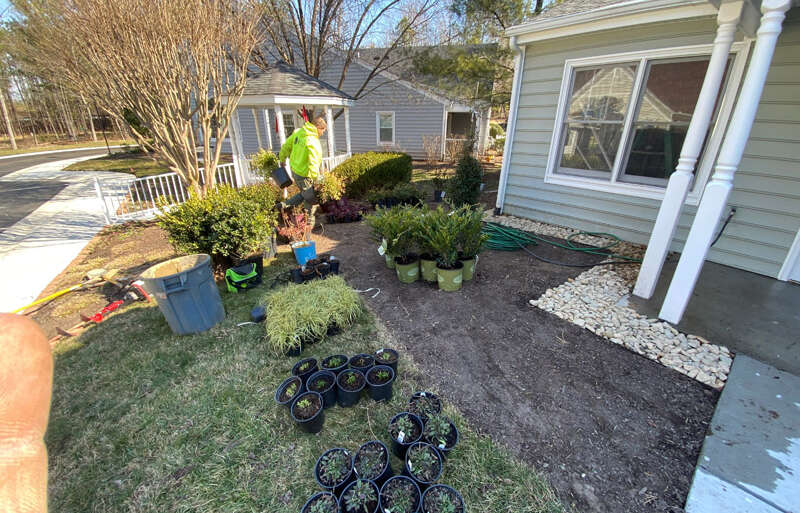 Winter is finally winding down in Central VA, and it’s time to think about pruning your trees and shrubs.
Winter is finally winding down in Central VA, and it’s time to think about pruning your trees and shrubs.
Ideally, January, February, and March are the best times to trim your
- Deciduous trees
- Crape myrtles
- And other woody plants.
Pruning Your Trees during Dormant Season
Did you know that late winter through early spring are the two best times for pruning your deciduous trees, such as maples, oaks, elms, and crabapples?
Indeed, your arborist can see the entire tree canopy in order to make the best cuts that respects the tree’s form and removes the branches that could cause disease or property damage.
For example, your field personnel will look for dead, diseased, and weak branches. They’ll also look for branches rubbing together because that opens up the bark to insects and disease.
If your trees took a beating this winter, your tree service will also remove storm-damaged limbs before they become a hazard.
Professional landscape companies use selective pruning to trim your trees and shrubs. Selective pruning involves specialized cuts of branches that keep the tree’s form while taking away unhealthy limbs.
Here are 10 benefits for selective pruning in late winter and early spring:
- Tree care personnel have better visibility and can make better decisions for what branches must go.
- Saves the homeowner and their property from less mess.
- Controls disease and insect infestation because the landscape maintenance crew can cut away infected branches.
- Stops the tree from bleeding too much. The cold temperatures keeps sap from flowing freely.
- Tree wounds heal faster, which prevents insects from burrowing into the cut areas.
- Oak trees are prone to oak wilt that spreads quickly during the summer. In January through March, there’s reduced risk of infecting an oak tree with oak wilt.
- Trees suffer less stress when trimmed back in the winter before new growth. It also allows for better leaf growth in the spring.
Read more: Looking Forward: What’s Trending in Landscape Design for 2021?
- Prepares your trees for spring winds and summer storms by removing any branches that could be torn from the tree in high wind.

- Pruning improves the tree’s structure and health, controls its size, and tidies the tree’s understory.<
- Tree topping damages your trees. Tree topping makes your trees look ugly, and it’s not selective pruning. A professional landscape company won’t suggest topping your trees.
Why Your Crape Myrtles Need Winter Pruning
Crape myrtles produce better blooms when they’re trimmed before bud break in the spring. If you choose not to prune your crape myrtles in the late winter or early spring, these beautiful trees may look unkempt.
Also, you don’t want to commit “crape murder” where the trees are topped. “Crape murder” results in knobby bark, weak limbs that droop low to the ground and produce fragile blossoms.
Instead, you want to highlight the natural beauty of crape myrtles, including their attractive bark, growth habit, and gorgeous clusters of flowers.
A professional landscape service will only cut the following from your crape myrtles:
- Any suckers growing from the low end of the trunk—suckers are shoots that grow out of the ground.
- Any tall limbs growing toward the center of the tree
- All side branches growing outward up to 4’ from the trunk.
Read more: How Plant Genetics Improve Each Year and How This Benefits You
- Any branches that are crossing and rubbing branches that open the tree up to insects and disease.
- Any dead limbs and branches that are growing out of form for crape myrtles.
Other Woody Plants That Benefit from Winter Pruning
Shrubs and other woody plants that need late winter pruning include
- Broadleaf evergreens, such as boxwoods and hollies, can be trimmed in early spring.
- Hedges, such as arborvitae, privet, and yews, can be reshaped in late winter.
- Deciduous shrubs, such as butterfly bush, Rose of Sharon, roses, and some hydrangeas, need selective pruning to reshape them.
While winter is wrapping up, there’s still time to get your pruning done before the weather warms up and leaves break their buds.
Why You Need a Professional Landscape Service for All of Your Tree and Shrub Pruning
When you hire a professional landscape company to prune your trees and shrubs in late winter and early spring, you know that you can trust them to employ selective pruning cuts.
Your trees, including your crape myrtles, won’t be topped but will be trimmed to enhance their natural form and beauty.
Make your tree and shrub pruning appointment today by calling us at (804) 752-0052 or filling out our contact form. We look forward to trimming your trees and shrubs in time for spring.
BCLS serves residential and commercial properties throughout Richmond and Central Virginia.
Sources:
ArborDay.org, “Arborist Advice: Why Should You Prune Your Trees during Dormant Season.”
NorthEscambia.com, “Stop Crape Murder: Don’t Cut Back Your Myrtles.”
PiedmontMasterGardeners.org, “When to Prune.”
SouthernLiving.com, “Crepe Myrtle Pruning Step-by-Step.”
Ibid, “Late Winter Pruning (January – February).”
TreesAreGood.org, “Pruning Trees.”



1 Comment
Alice Carroll
Thanks for explaining the stress levels that I have to consider when it comes to tree pruning. I’m thinking about getting a tree pruning service early next year because I’d like to spend the spring revitalizing my garden. That will require me to also make some necessary adjustments to make my tree a bit more appealing to the eye.
Comments are closed.